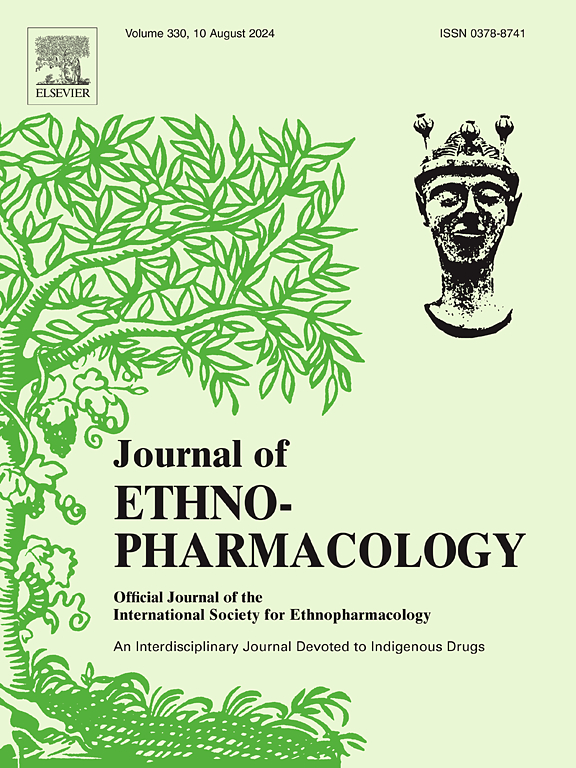Fabiana bricata Ruiz & Pav。(茄科)精油在前列腺癌细胞中的分析:活性氧在促凋亡活性中的相关性。
IF 5.4
2区 医学
Q1 CHEMISTRY, MEDICINAL
引用次数: 0
摘要
民族药理学相关性:Fabiana bricata Ruiz & Pav。(茄科)是一种巴塔哥尼亚植物,在传统医学中广泛使用,特别是作为利尿剂,消化和生殖-泌尿系统疾病。精油被认为是前列腺癌治疗的有希望的候选者。前列腺癌是男性死亡的第二大原因。因此,需要新的治疗策略来预防这种肿瘤。目的:研究采自智利Valparaíso地区的枫香植物鲜叶精油的化学成分及其对人前列腺癌细胞的活性。材料与方法:采用色谱技术进行化学表征,并在雄激素敏感(LNCaP)和雄激素不敏感(DU-145)人前列腺癌细胞株中进行生物活性评价。将细胞暴露于精油中72小时,评估细胞活力和细胞膜完整性。检测基因组DNA和caspase-3活性,证实细胞凋亡所致。Western blot检测Bcl-2、Bax、cleaved caspase-3、cleaved caspase-9、SOD、Hsp70、STAT-3蛋白的表达。还进行了活性氧(ROS)和谷胱甘肽(GSH)水平的测定。结果:挥发油有效成分(含氧倍半萜,77.54%)对前列腺癌细胞有明显的抑制作用。在浓度为200 μg/ml时,LNCaP和DU-145细胞的细胞存活率分别为23%和26%。相反,在这种高浓度下,它对正常细胞没有明显的影响。此外,它诱导凋亡细胞死亡,涉及Hsp70和STAT-3蛋白的下调,至少部分与活性氧(ROS)的增加相关。结论:本体外实验临床前研究提示了荆芥精油在前列腺癌治疗中的潜在应用,可作为进一步设计动物实验模型及研究其有效成分的起点。本文章由计算机程序翻译,如有差异,请以英文原文为准。

Fabiana imbricata Ruiz & Pav. (Solanaceae) essential oil analysis in prostate cancer cells: relevance of reactive oxygen species in proapoptotic activity
Ethnopharmacological relevance
Fabiana imbricata Ruiz & Pav. (Solanaceae) is a Patagonian plant widely used in traditional medicine, in particular as a diuretic, digestive and for genito-urinary system diseases. Essential oils are considered promising candidates for prostate cancer treatments. Prostate cancer is the second leading cause of death among men. Therefore, new therapeutic strategies of prevention are needed for this tumor.
Aim of the study
The present research was designed to explore the chemical composition of essential oil from fresh leaves of F. imbricata plants collected in Valparaíso region, Chile, and its activity on human prostate cancer cell lines.
Materials and methods
Chemical characterization was performed by chromatographic techniques and the biological activity was evaluated in androgen-sensitive (LNCaP) and androgen-insensitive (DU-145) human prostate cancer cell lines. The cells were exposed to essential oil for 72 h and cell viability and cell membrane integrity were evaluated. Genomic DNA and caspase-3 activity was tested to confirm the cell death for apoptosis. Western blot analysis was employed to evaluate the expression of Bcl-2, Bax, cleaved caspase-3, cleaved caspase-9, SOD, Hsp70 and STAT-3 proteins. Assays to evaluate reactive oxygen species (ROS) and GSH levels were also performed.
Results
The results showed the capacity of essential oil, for its active components (oxygenated sesquiterpenes, 77.54 %), to reduce cell viability in prostate cancer cells. At a concentration of 200 μg/mL, the cell viability in LNCaP and DU-145 cells, was 23 % and 26 %, respectively. On the contrary, it showed no significant effect on normal cells, also at this high concentration. In addition, it induced apoptosis cell death, involving the downregulation of Hsp70 and STAT-3 proteins, correlated, at least in part, to an increase of reactive oxygen species (ROS).
Conclusions
This in vitro experimental preclinical study, suggesting a potential application of F. imbricata essential oil in prostate cancer, could be considered as a start point to design further research in animal experimental models and on its active components.
求助全文
通过发布文献求助,成功后即可免费获取论文全文。
去求助
来源期刊

Journal of ethnopharmacology
医学-全科医学与补充医学
CiteScore
10.30
自引率
5.60%
发文量
967
审稿时长
77 days
期刊介绍:
The Journal of Ethnopharmacology is dedicated to the exchange of information and understandings about people''s use of plants, fungi, animals, microorganisms and minerals and their biological and pharmacological effects based on the principles established through international conventions. Early people confronted with illness and disease, discovered a wealth of useful therapeutic agents in the plant and animal kingdoms. The empirical knowledge of these medicinal substances and their toxic potential was passed on by oral tradition and sometimes recorded in herbals and other texts on materia medica. Many valuable drugs of today (e.g., atropine, ephedrine, tubocurarine, digoxin, reserpine) came into use through the study of indigenous remedies. Chemists continue to use plant-derived drugs (e.g., morphine, taxol, physostigmine, quinidine, emetine) as prototypes in their attempts to develop more effective and less toxic medicinals.
 求助内容:
求助内容: 应助结果提醒方式:
应助结果提醒方式:


